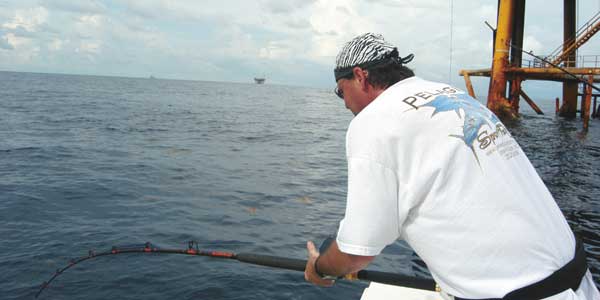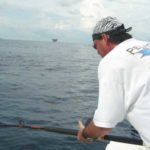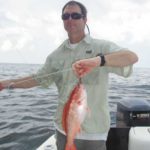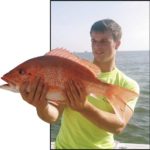
Will AMOs keep red snapper stocks from plummeting into oblivion? We may soon get the chance to find out.
The Gulf of Mexico red snapper fishery has become the poster child for fishery management failure in the United States. Fisheries management experts paint an ever more-gloomy picture for the recovery of the fishery. Commercial hook-and-liners blame recreational and charter fishermen for running over their quota, recreationals blame shrimp trawlers for their bycatch of juvenile snapper and environmentalists blame them all.
While the assignment of individual fishing quotas (IFQs) to commercial red snapper fishermen seems to have stabilized that sector somewhat, recreational/charter fishermen often bust their share of the total allowable catch (TAC), and their seasons are being shortened and their bag limits reduced.
Seeming to signal their frustration with managing the recreational/charter fishery, the Gulf of Mexico Fishery Management Council has created an Ad Hoc Recreational Red Snapper Advisory Panel solely to look at “innovative management strategies for private and for-hire recreational fishermen.” The panel met for the first time in January 2008, and at least one idea completely alien to recreational fishing mentality was broached.
That idea was the formation of Angling Management Organizations (AMOs). The use of AMOs as a recreational fishery management tool was first proposed in 2003 by two fisheries economists, Jon Sutinen of the University of Rhode Island and Robert Johnston of the University of Connecticut.
AMOs, as proposed by Sutinen and Johnston, are non-governmental organizations of recreational and/or charter anglers to which a share of the recreational TAC for red snapper would be assigned. This share would be an angling right that would, in reality, be owned by the AMO.
AMOs would take the form of a conventional business entity, such as a corporation, limited liability company or limited partnership. Shares of the AMO would be able to be publicly traded.
Individual AMO shareholders would not automatically own a share of the quota, however, or any right to a certain quantity of the harvest. Rather, the AMO shareholders would collectively share the authority to manage the quota under the control of the AMO. This would include distributing harvest rights to AMO members and non-members.
Ideally, all anglers would have equal right to attempt to access the fishery through the AMO, although the AMO must have the right to restrict access somewhat, or effective management would be undermined.
As a business entity, an AMO would have the right to charge fees for licenses or right to harvest certain quantities of the harvest, to auction off the right to fish in certain areas, conduct for-profit fishing tournaments or have lotteries for rights to fish in prime fishing grounds.
The right to raise money from the resource provides the incentive for the AMO to properly and effectively manage its share of the TAC. AMO shareholders could sell or trade their share of the AMO to other individuals, even commercial fishermen, or other AMOs. An AMO could impose surcharges on share transfers as another method of raising revenue. A profitable AMO could even raise money by creating and selling more shares.
Each AMO is envisioned to have the authority to decide whether or not to allow its anglers to sell their catch. Allowing the sale of catch would result in more efficient utilization of the resource and enhance the value of the recreational fishery.
The quota rights held by each AMO should include rights for a specific area as well as for specific number of fish from the TAC. Control of an area would allow AMOs to ease conflicts between groups and fishing methods and avoid overfishing of favorite fishing locations.
To handle area rights, AMOs could be set up several ways. One would be to allow only one AMO, regardless of ownership, in an area. In another approach, an AMO owned by charter operators could function in the same area as an AMO owned by private-boat anglers.
Once AMO management is adopted, the government would devolve most of its management authority to the AMO, keeping only the right to set TACs and to establish closed areas. Size restrictions, bag limits, fishing times and gear restrictions would be set by the AMO. The AMO would have the absolute responsibility to make sure that its share of the TAC is not exceeded. Violating the TAC could result in a temporary or permanent reduction in harvest rights.
Angling management organizations may sound like an almost Orwellian concept. Most of today’s American anglers were weaned on the belief that after paying a minimum license fee, they can fish anywhere their boats can carry them, with the only restrictions being on fish sizes and numbers. What has driven modern fisheries managers to look at such concepts as AMOs and marine protected areas?
A recent report by the National Academy of Public Administration concluded that the federal fisheries management system is struggling, cumbersome and inflexible. Some scientists feel that continuing to use only existing management measures such as size limits, bag limits and seasons is doomed to failure because they cannot address pressures related to growth in numbers or fishing efficiency in recreational/charter fisheries, nor can they address conflicts with other resource users, including the environmental community.
Worldwide, the three biggest trends in fisheries management are management devolution, strengthened harvesting rights and co-management. AMOs address all three.
Management would devolve increasingly from the federal government to the AMO, the AMO’s quota rights would strengthen harvest rights and the AMO shareholders would be partners in managing the resource rather than being subjects to be managed by the government.
Theorists point to many potential benefits. Enforcement costs would be dramatically reduced, since the penalties of exceeding the AMO’s quota would create incentives for self-policing of member anglers. Full participation in the management process by recreational/charter anglers would likely increase compliance, both because of an increased sense of stewardship and because rules would be better tailored for local needs.
For example, the current Gulf-wide recreational/charter season for red snapper is set to be open for the peak of the Texas tourist season, but closed during the late-winter period in which red snapper are found clustered closer inshore than in the summer. An AMO could set and administer a different season for Louisiana than for Texas, and thereby increase satisfaction and compliance with the rule.
Improved conservation is projected, as well. AMOs would directly suffer the consequences of decisions that result in poor management and the benefits that result from good management. If a fishery stock improves and the total TAC increases, an AMO’s share (and value) will increase in proportion and vice versa.
Using AMOs is a form of “rights-based” natural resource management. Under rights-based management, strong property rights to the resource are assigned to fisheries users. Rights-based management regimes in commercial fisheries, such as the use of individual fishing quotas, have had strong success in the United States and other countries throughout the world.
Many countries, including Canada, Denmark, the Netherlands, Norway, Sweden and Britain, are decentralizing fisheries management as well, by devolving management authority to fishermen and their organizations. Are we ready for such changes in the U.S., with our strong history of public ownership and control of fish and wildlife?
Walter Keithley, fisheries economics professor at LSU, isn’t so sure. He says that he is devoting his time to things that are more likely to happen in the near future.
Assane Diagne, a fisheries economist with the Gulf of Mexico Fishery Management Council, is more guarded. He said that AMOs were just one of an array of management options touched on at the first meeting of the Ad Hoc Recreational Red Snapper Advisory Panel.
“It was just one idea, one option,” Diagne said. “The next meeting of the panel will be in Mobile at the end of March. Then we will see if they want to take it up.”
Myron Fischer, skipper of the charterboat Different Drummer, was until recently a voting member of the Gulf Council and represents Louisiana as a member of the new Ad Hoc Advisory Panel. In his view, the first meeting of the panel was not as strong of a working meeting as later meetings will be, so it’s hard to tell how the concept of AMOs will be received by either charter or private-boat anglers.
Fischer said the group still needs to compile more options for their consideration list before even beginning to look at each and starting the process of elimination.
Fischer did say that he and several of the other panel members are somewhat cautious about making large-scale, long-term changes in management while the next few years look so hard.
“The cut of the recreational quota in half is very serious, and will be difficult to live with,” he said. “We need to figure out ways to survive the next couple of years until the next stock assessment is done in 2010.”
Fischer expressed optimism that the next stock assessment would show enough improvement in the red snapper population to get limits back up to where they were before the recent cut.
“Before individual fishing quotas were put in place for commercial snapper fishermen, they had to target red snapper when the season was open and then couldn’t keep any red snapper during the closed part of the season, when they were fishing for beeliners, mangrove snapper and grouper,” he said. “They had to throw a lot of bycaught red snapper back, and there was a lot of mortality on those. Now they can keep the red snapper they catch while fishing for other reef fish. That should help.
“There aren’t any shrimp boats fishing out there, and the ones that are left are not fishing way offshore in snapper waters because of fuel costs. That will make a difference in red snapper bycatch.”
Fischer said the hit that the commercial and recreational red snapper fishermen took in their quotas will leave a lot more fish in the water, as well.
“What this panel needs to do is figure out a way that we can live for a couple of years until things stabilize,” he said. “We can already see improvement, so the stock assessment should reflect what we’re seeing. What we don’t want to do is something drastic, just to solve what may be a short-term problem.”
Fischer said that his biggest worry about AMOs is the disorganized state of Louisiana’s charter fisheries.
“Other states have well-organized groups with political clout and lots of money,” he said. “Louisiana is poorly organized and has no political clout compared to out-of-state groups. If it takes organization and money to get a fair share in AMOs, I worry that Louisiana will get nothing.”
Fishermen, recreational, charter and commercial, are by their very nature resistant to change. Most know what they have now, no matter how bad it is, and prefer it to the unknowns that come with change.
The concept of AMOs, as “off the wall” as it may seem now, is not likely to go away, though. It will likely pick up a new name or two, shift subtly in emphasis, and continue to gain adherents, probably first in the environmental community, which is playing a bigger and bigger role in fisheries management.
A few short years ago, the concept of marine protected areas seemed utterly alien, almost un-American, to the fishing community. Now we have more of them, most currently created by presidential decree, and more will almost definitely come.
The wheels of change grind slowly, but they continue to grind. Twenty years ago, when limited entry for red snapper was proposed, it was deemed “a communist plot” at public hearings by commercial fishermen.
In 1995, the Gulf Council put its stamp of approval on a severe form of limited entry, individual fishing quotas for commercial red snapper fishermen.
Twelve years later, after enduring Congressional interference and scrutiny, IFQs are a reality in the fishery — and they are embraced by most.





